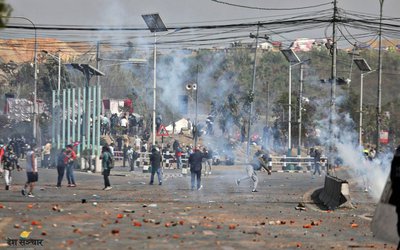
Newspapers of Nepal in both Nepali and English languages are fully colorful capturing the stories of abuse of authority and corruption almost every day. Some stories are on yellow metal captures and sudden disappearances of the gold; bribes taken by the civil servants, police including ministers while others are from customs or tax policy change to awarding of contracts such as the case of electric cars, to 33 billion railway contract even before the country has acquisitioned the land for the railroad. Recurrence of such stories in the newspapers, almost every day, has developed a trust deficit between the government and the public, who view, in general, that most initiatives taken by civil servants, policy makers and policy implementer are a manifestation of 'neo' corruption either ‘petty’ or ‘grand’.
Although what can be called corruption may be culturally and socially contextual, and the definition is vague as well as elusive for its multi-pronged and multi-dimensional nature, scholars studying it agree that corruption occurs when there is malfeasance, an official misconduct done in an official capacity for personal gain and/or use of public office for personal interests and benefits. This is equally applicable from the lowest ladder of public positions to highest levels. Implicating this into the context of Nepal, both ‘petty corruption’ and ‘grand corruption’ are considered to be widespread in the recent years of Nepali history.
Just to put them into context, ‘petty corruption’ means extorting money or any other favors as a price for goods or services such as freely rationed food or free medical services under the scheme of a national health service or while obtaining a document such as a passport or a driving license, to which the citizens are automatically entitled for free or at a low price service. Another variant of ‘petty corruption’ involves extracting money to convey a favor by abusing public authority for which the applicant does not entitled to or qualify. Examples of these include,a land revenue officer waiving land tax or a customs officer waiving import duty in exchange for small to big kickbacks. The public perception and actual public experience shows that ‘petty corruption’ practices are widespread in the country and if bribe is not paid for obtaining services from public offices, they often results into prolonged delays.
On the other hand, ‘grand corruption’ means larger deals where in exchange for bribes or kickbacks, politicians or bureaucrats award government contracts for supply or construction, overpay providers of public services, give public property including land for free or at a low price, and grant waivers or exemptions from regulations. Another variant of ‘grand corruption’ is to buy off politicians during elections or any other time in order to continue the government of the day or topple it down; to secure business monopolies in the markets or to secure favorable laws that create huge private profits.At times, in ‘grand corruption’ businesses can collude with politicians, civil servants or regulators to create monopolies for their mutual benefit at the expense of the public, against the public will. It can also include the instances where ‘politicians’ and officials’ share government’s inside information about future public projects to help make abundance of private profit by acquiring lands or businesses that stand to benefit from the projects.
Lately, stories related to ‘grand corruption’ are widespread and extensively discussed in public spheres. COVID-19 medical supply purchase scandals including Omni; security printing press scandal, and business tax policy change in 'setting' to benefit top business houses and oligarchs are a few selective examples. And all these forms of corruption exist in a country when the top notch leadership,executive, legislature, judiciary and other key anti-corruption institutions from CIAA, to OAG established to eliminate corruptive practices, continue in colluding and facilitating them by being complicit in the abuse of public authority and by letting off any prosecuted civil servants, officials or politicians by manipulating the principles of rule of law and good governance in ‘setting’ as there are often partnerships between culprits, and public officials from judiciary, executive, legislature and bureaucracy.
Historical analysis of existence of corruption in the countries of the world shows that some or all of the forms of ‘petty and grand’ corruptions have existed in most of the countries and throughout history. Since Kautilya wrote: ‘Just as it is impossible not to taste the honey or the poison on the tip of the tongue, so it is impossible for a government servant not to eat up at least part of the king’s revenue’in his Arthashastra about 2000 years ago, corruptive practices have existed widespread but there has been a number of changes in the trends of corruption in the world. The trend of corruption in developed countries is falling down while it is rising up in developing countries.For examples, according to Corruption Perception Index (CPI) of Transparency International, Denmark and New Zealand have scored 87 out of 100 while Somalia scored 9 and South Sudan scored 12 out of 100 (100 is the best and 0 means the worst) in 2019. The case of Nepal is also the worst as it scored only 34 out of 100 and stood at 113th position out of 198 countries. The data of CPI from 2012 to 2019 do not fluctuate much in the case of Nepal and the rate of corruption remains intact or increasing consistently, which seriously challenges the primary promise—I don’t take bribes, I don’t give bribes and I don’t tolerate corruption—of the current administration and reiteration of introducing good governance in the country.
The question now arises is, why Nepal fails to reduce or eliminate corruption even if the Supremo of the current administration keeps echoing that his administration has a policy of zero tolerance against corruption. Firstly, the role of top-notch leadership to support anti-corruption initiatives is profoundly significant compared to any other measures and many research have already demonstrated that lack of support from the top leadershipis the biggest obstacle of anti-corruption initiatives and so is the case, on lip service only, in Nepal. Next important issue for tackling corruption is to change status quo social perception to enlightened one, which can clearly reject all corruptive practices whether it starts from family, friends, businesses or public offices. Thirdly, there should not be a lack of public access to information particularly in the processes of planning, procurement, and expenditures. Fourthly,the state power needs to transfer from one generation to another without allowing a limited number of septuagenarian and octogenarian politicians to capture state power for long period of time to continue pervasive corruption sans any reforms in action. Fifthly, clean people, not corrupted ones, need to be given leadership of anti-corruption bodies and these bodies need to be ethically and morally professional and avoid any taint of corruption within themselves and collaborate effectively to curb corruption. Sixthly, the anti-corruption actions must collaborate with the media inclusive of social media,academia, wider public awareness and will along with reliable investigation of the corruption cases, having robust networks of corruption information and communication. An assertive anti-corruption commitment from the top leadership in action instead of lip-service, inclusive of all the other components discussed above can direct Nepal towards reduced or sans corruption good governing country and help it secure global clean image with multiple benefits.
Dr. Chandra Lal Pandey is the Program Coordinator and A. Professor at the Community Development Program, School of Arts, Kathmandu University.

Dr. Chandra Lal Pandey
Dr. Pandey is the Program Coordinator and member of faculty at the Community Development Program, School of Arts, Kathmandu University.
- 16thPeriodic Plan for Delivering Basic Services and Fundamental Rights?
- Feb 08, 2024
- Disaster Governance: Theory And Practice In Nepal
- Dec 05, 2023
- Haphazard Urbanization Or Sustainable Smart Cities In Nepal?
- Jun 28, 2023
- Say No To Pre-Election Coalition
- Jul 14, 2022
- Nepalis Are Optimistic:Findings Of SNP 2020
- Apr 12, 2021














